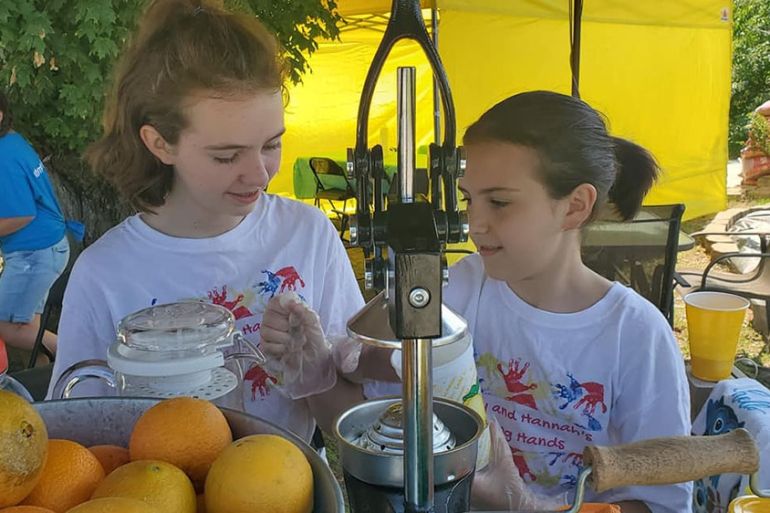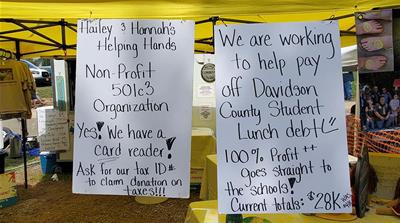The other student debt: US kids struggle to pay for school meals
With unpaid meal debt topping $10m, advocates say it is time that all United States students had a free lunch.

When sisters Hannah and Hailey Hager learned that some of their classmates in Davidson County, North Carolina were struggling to pay for their meals at school, they didn’t see it as someone else’s problem to solve.
Hannah, 12, and Hailey, 14, started selling lemonade on weekends to help pay off the roughly $35,000 in lunch debt that schoolkids in Davidson County owed by the end of the last school year.
Keep reading
list of 4 itemsCalifornia university will heed student call to boycott Israel institutions
US university ties to weapons contractors under scrutiny amid war in Gaza
UC Berkeley chancellor speaks out about ‘Gaza brutality’
“My friend couldn’t buy food at school because she didn’t have the money,” Hannah, who just started sixth grade, told Al Jazeera. “She came up to me in the hallway and said, ‘Hey, Hannah, the school just gave me a paper that said how much debt I’m in.'”
“Whenever you go to school, what helps you to think in class is food, so you’re not thinking about how hungry you are and have energy,” said Hailey, who just started eighth grade. “You’ve got to have your lunch.”
To date, the young activist sisters have raised $13,252.17 for 20 Davidson County schools, with six schools’ balances left to wipe out, according to their mother, Erin Hager.
“It’s a big issue. We’re in the United States and there are kids going hungry, for goodness’ sake,” Erin Hager told Al Jazeera. “It seems like an oxymoron.”
Churches and other donors also took action, and along with the Hager sisters, helped to slash the county’s school meal debt by around half, according to Davidson County Schools’ Chief Finance Officer, Tyler Beck.
The effort is laudable. But for some advocates, the real solution lies not in paying off school meal debt, but in making school meals free for students.

A growing problem
Davidson County is just one example of a growing problem across the US.
The median amount of unpaid meal debt by school district across the US has soared 70 percent over the past six years, according to the School Nutrition Association (SNA). At the close of the last calendar school year, 75 percent of school districts reporting to SNA had unpaid meal debt ranging from $10 to $500,000.
“Our organisation has advocated for many years for universal, free school meals,” Diane Pratt-Heavner, the SNA’s director of media relations, told Al Jazeera. “School meals are just as important to kids’ success as books and pencils and paper, and hungry children cannot learn. They need to be well-nourished to be able to focus, in their afternoon classes in particular.”
Some presidential candidates have advocated for universal free meals to address the crisis as well. US Senator Bernie Sanders of Vermont proposed year-round, free school meals for all children, and Representative Julian Castro of Texas has said he would expand free breakfast and lunch to all public school students.
The cost of school meals varies widely depending on where you are in the US, but on average, school lunch costs $2.48 for primary schools and $2.74 for secondary schools nationwide, a 2018 SNA study found, while the average breakfast costs $1.46 for primary schools and $1.55 for high schools.
The amounts may seem modest, but bills can add up quickly given there are about 180 days in the average school year, according to the National Center for Education Statistics. A high school student buying breakfast and lunch can end up shelling out about $770 per year- a significant sum for many low- and middle-income families in the US.
To put this in perspective, a recent study by the US Federal Reserve found that nearly 40 percent of US households would struggle to pay for an unexpected $400 expense.
We know there are plenty of children who are not income-eligible for free meals but whose parents are still having trouble making ends meet.
Not covered by guidelines
Under the current guidelines set by the US Department of Agriculture (USDA), only children whose families live at or below 130 percent of the federal poverty line – set at $33,475 for a family of four for the 2019-2020 school year – qualify for free school meals.
Children from households with incomes between 130 percent and 185 percent of the poverty line – $33,475 to $47,638 for a family of four – qualify for reduced-price meals. Everyone else must pay full price.
But those guidelines don’t accurately reflect national need, argues Janet Poppendieck, City University of New York professor and author of Free for All: Fixing School Food in America.
The USDA income thresholds for subsidised school meals are not adjusted for differences in the cost of living, which vary widely across the US.
“We know there are plenty of children who are not income-eligible for free meals but whose parents are still having trouble making ends meet,” Poppendieck told Al Jazeera.
And the federal government is not allowed to step in and help. The USDA mandated in 2017 that federal funds cannot be used to pay off student meal debt.
That means the burden of assisting kids whose families do not qualify for free or reduced-price school meals falls entirely on local districts.
“Schools are having to look to charitable contributions to cover the cost, but when charitable contributions aren’t available or sufficient, they’re having to look at general education funds,” said Pratt-Heavner.

From ‘lunch shaming’ to free lunch
Left to their own devices, some school districts have resorted to “lunch shaming” children who can’t pay for their meals by forcing them to wear stickers or eat different foods from their non-debt-holding peers.
Some school districts have even taken meals out of kids’ hands and thrown them away, all of which “clearly result in embarrassment and discomfort,” Poppendieck said.
“For schools to have uncollected money is an issue, but to put the burden on children strikes me as totally contrary to our values and our understanding of what childhood should be like,” Poppendieck said. “The most egregious situations are the ones in which the meal is confiscated, and then because it can’t be eaten after it’s been selected by one student and it can’t be returned to supplies, it’s tossed.”
The solution, advocates say, is a simple one: offer free meals to all students. That would eliminate the time and money schools spend on processing federal free and reduced meal applications, tracking meal debt and determining who pays what at the cafeteria cash register, said Crystal FitzSimons, a director at Food Research & Action Center, a nonprofit working to eradicate poverty-related hunger and undernutrition in the US.
“Offering free meals to all kids would solve the problem immediately,” FitzSimons told Al Jazeera. “And we are seeing more and more schools offer free breakfast and lunch to all students.”
New York City and Boston are among the cities that now offer free breakfast and lunch to all public school students. Poppendieck said she would like to see such action taken on a federal level, and have the federal government pick up the tab by taxing higher incomes at higher rates.
And Poppendieck says it’s “heartening” to see families, children and charities step up to pay off student meal debts, she notes “this is a situation where public policy is creating the problem, and I don’t think it’s appropriate to rely on the generosity of individuals and GoFundMe campaigns. I think we need to change the policy”.
Until it does, Davidson County has the Hager sisters, who have vowed to keep battling school meal debt one lemonade sale at a time.
“It’s not fair that some kids can’t do things because they don’t have enough money to pay it off, or they’re not able to eat and go hungry because of having a debt,” said Hannah.